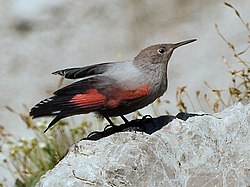| Tichodroma Temporal range: Late Miocene - Recent | |
|---|---|
 | |
| Scientific classification | |
| Kingdom: | Animalia |
| Phylum: | Chordata |
| Class: | Aves |
| Order: | Passeriformes |
| Superfamily: | Certhioidea |
| Family: | Tichodromidae Swainson, 1827 |
| Genus: | Tichodroma Illiger, 1811 |
| Species | |
| |
Tichodroma is the only known genus in the family Tichodromidae. Initially, Linnaeus placed Tichodroma in the family Certhiidae, along with the treecreepers, [1] while other authorities have placed it the nuthatch family Sittidae, as its own subfamily. A 2016 phylogenetic study of members in the superfamily Certhioidea suggests it is a sister of the Sittidae. [2]
| |||||||||||||||||||||||||||||||||
| Relationships among families in the superfamily Certhioidea. [3] [4] |
The wallcreeper (Tichodroma muraria) is the only extant species, but the extinct Tichodroma capeki is known from the Late Miocene of Polgardi, Hungary. [5]